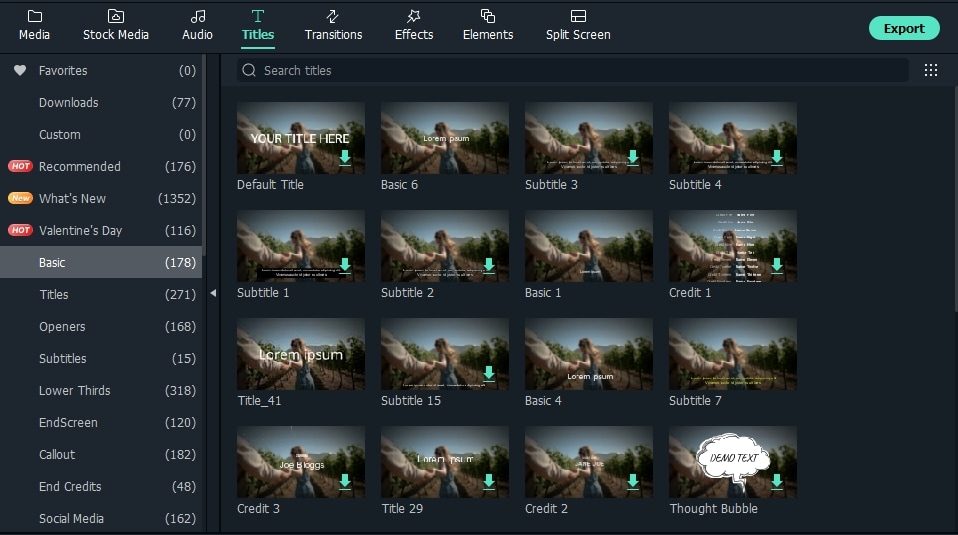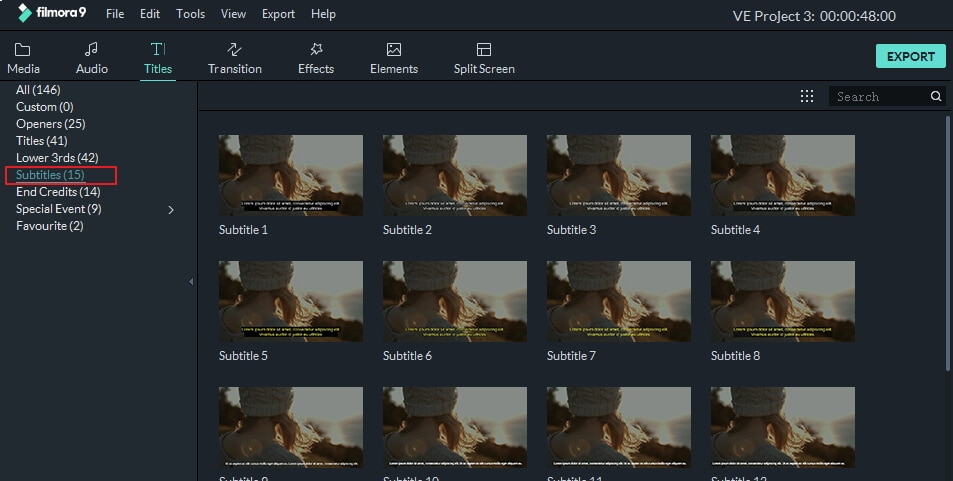In today’s tutorial, we are going to show you how to create openers, titles, lower thirds, subtitles, and credits with Filmora9.
Exploring the Titles tab
Opening titles or end credits are an integral part of short videos as well as full feature movies. Finding creative ways to use text to tell the story of your video can help you captivate the audience’s attention from the first frame of your video. Filmora9’s Titles tab contains over a hundred text presets you can use to add textual elements to the footage.
The Titles tab is divided into Openers, Titles, Lower 3rds, Subtitles, and End Credits categories. The All category that lets you see all templates located in the Titles tab is going to be selected by default.

Click on the Openers category to create an opening title for your video. While browsing through the collection of openers you can double-click on an opener you’d like to preview and it will automatically start playing in the Preview Window. To add an opener to the timeline, simply drag and drop it to a particular location on a video track. The difference between an opener and a title is that an opener usually contains a background. That is why you have to place an opener at the very beginning of the timeline and before any other footage you added to the timeline.
Double-clicking on an opener on the timeline will bring up the Text Editor where you can adjust any preset you selected to the demands of your project.

The text editing tools the Text Editor offers are the same for all types presets, so once you learn how to create an opener you’ll also know how to add subtitles or end credits to a video. Within the Text Editor window, you’ll see the Font, Settings, Transform and Compositing submenus.
You can click on any of these submenus to expand or collapse them. Make sure that the text layer to which you want to add text is selected, by clicking on that layer in the preview window. To reposition a text layer anywhere within the frame, simply drag the text layer to a new position.
Before you start typing the text into the textbox located in the Font submenu, you can select another font from the drop-down menu, increase or decrease the size of the text, use the alignment tools and make text bold or italic.
The Settings submenu enables you to choose the color of the text, adjust text and line spacing or align the text to a particular point in the shot. Click on the Text Color drop-down menu to select the new color of your text. The More option lets you choose from the whole spectrum of color, which grants you more freedom in picking the color of your text. Use the Pick Screen Color option in case you want to take a color from a certain portion of the screen and apply it to the text.
The Text Space option allows you to specify the distance between each character in the text, while you can use the Line Space option to control the distance between two lines of the text. If you would like to attach the text to a certain point in the frame, simply click on the Alignment icon. The Text Layer feature lets you switch between different text layers while working on openers that contain more than one text layer.
Head over to the Transform submenu if you want to reposition a text layer. Use the Rotate slider to rotate a text layer or drag the handle on the Scale slider to increase or decrease the size of a layer. Insert the exact screen coordinates into the X and Y boxes next to the Position option to place a text layer at a particular part of the screen.
The Blending Mode drop-down menu that offers a variety of methods for blending text and images is located under Compositing, so you can choose how your media files are going to be blended. Reducing the Opacity value enables you to make a text layer transparent.
In the upper right corner of the Text Editor, you’ll see the Preset and Animation tabs. The Preset tab features more than twenty text styles and you can apply any of them to a text layer by simply double-clicking on them.
Animating text in Filmora9 is easy since you just have to go to the Animation tab and double-click on the animation you want to apply to a text layer. Once you’re done editing the opener you should click on to Save as Custom button in case you want to use an opener more than once.

All custom titles you create in Filmora9 are going to be located in the Custom category of the Titles tab. Any of the presets located in Openers, Titles, Lower 3rds, Subtitles or End Credits categories can be added to the Favorite category by right-clicking on a preset and choosing the Add to Favorite option.

The Titles category features a selection of titles that let add text over the footage. These text overlays can be used at the beginning of a video or to introduce a new chapter in the story. The Lower 3rds presets are commonly used to introduce a new person in a video to the audience.

Consider adding subtitles to a video if you want to make the dialogues in your video easier to follow. Creating subtitles in a language that is different than the language used in a video can potentially extend the scope of the video’s audience.
Filmora9 offers a broad range of end credit styles you can choose from. Simply add the one you like the most to the timeline and proceed to customize it from the Text Editor panel.
The duration of each text preset you placed on the timeline can be changed by making sure you selected it properly and dragging one of its ends to the left or right. This allows you to precisely set the text preset’s location on the timeline.
You can visit the Filmstock effects store, directly from the All category in the Titles tab and download more Title presets as well as various other media assets that can make your video more fun to watch.

